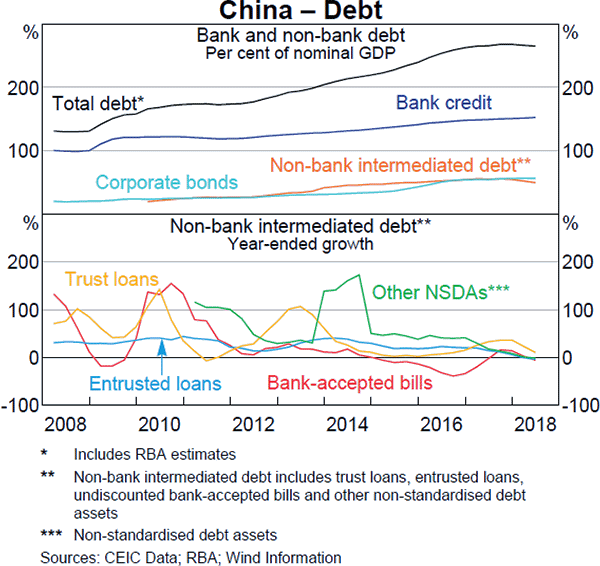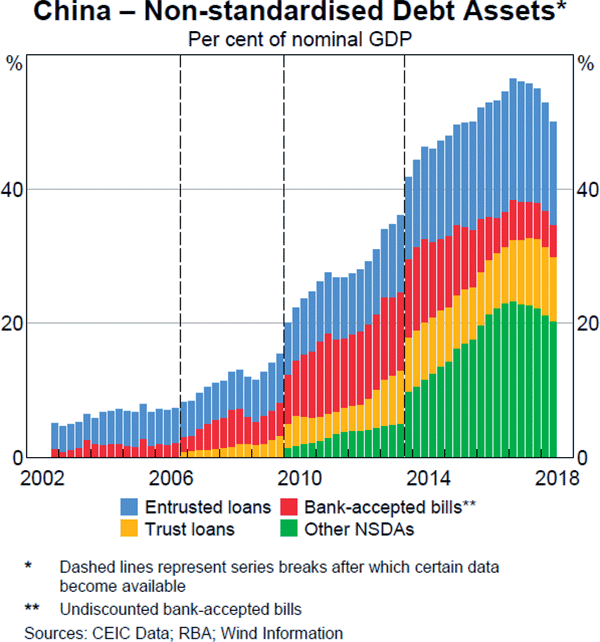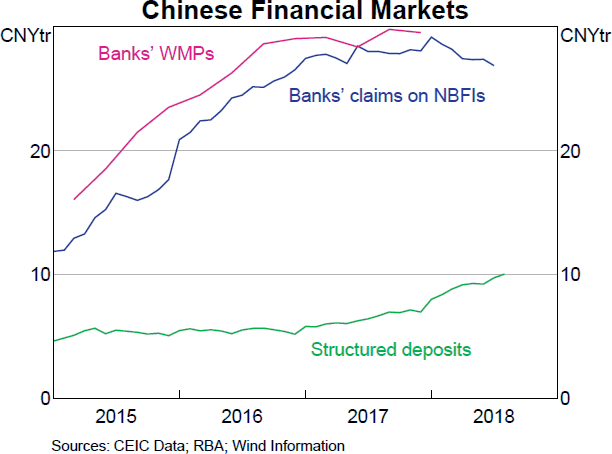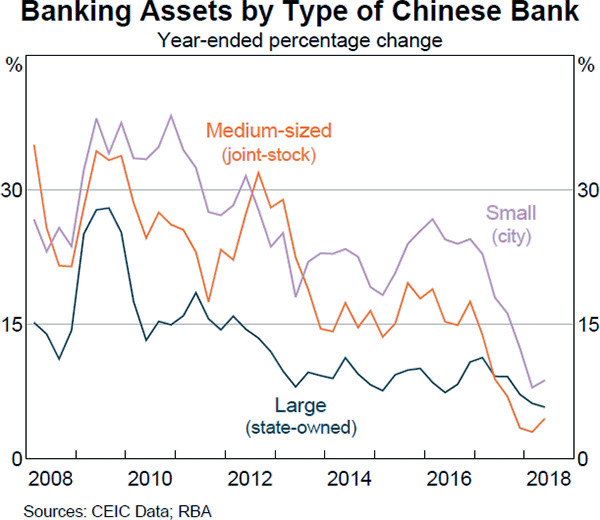Financial Stability Review – October 2018 Box A: Ongoing Financial Regulatory Reform in China
Financial stability risks remain a key focus for the authorities in China. President Xi Jinping has characterised the management of financial stability risks as a national security issue. To address the build-up of risks, the Chinese authorities have announced a series of reforms in recent years. These have focused on reducing indirect lending undertaken through the non-bank sector, simplifying complex interconnections within the financial system, reducing high levels of corporate leverage, and improving banking system resilience. This box focuses on the reforms undertaken over the past year. It discusses the effect of reforms to date on lending and considers some implications for growth. Over the past year: regulatory oversight has been consolidated; existing regulations have been enhanced and more strictly enforced; and sweeping asset management sector reforms have been finalised. Several indicators suggest that the reforms are gaining traction; for example, measures of non-bank lending growth have slowed. However, the regulatory tightening appears to be resulting in tighter financing conditions for businesses and is weighing on growth in parts of the economy.
Reforms up to mid 2017 focused on lending through the non-bank sector
Regulatory reform to address financial stability risks has been an ongoing process that started in earnest several years ago.[1] Reforms in recent years focused on reducing ‘channel lending’. Channel lending is where banks lend or invest using non-bank financial institutions (NBFIs) to intermediate between the bank and the borrower. Banks typically fund this lending using short-term funds raised from other banks or retail investors. This form of regulatory arbitrage has raised significant credit, liquidity and contagion risks. Reforms in recent years have included: measures to reduce banks' ability and incentive to engage in channel lending; proposals to improve the transparency and risk management of asset management products (AMPs) issued and used by banks and NBFIs to facilitate channel lending; and restrictions on short-term interbank lending and borrowing. These reforms were complemented by the People's Bank of China (PBC) revising its macroprudential assessment (MPA) program to include off-balance sheet assets, such as AMPs, in banks' prudential assessments.
Regulation has tightened further since 2017, especially for the asset management sector
Over the past year, authorities have more strictly enforced existing regulation and finalised additional reforms that focused on: consolidating regulatory oversight; further reducing channel lending by implementing the asset management reforms; and increasing resilience in the banking sector. The consolidation of regulatory oversight should reduce regulatory arbitrage (by revealing regulatory gaps and fostering similar regulation of similar activities). A new Financial Stability and Development Committee, chaired by a Vice Premier, was established under the State Council. This committee aims to boost coordination between the main Chinese financial regulators and increase their authority. The banking and insurance regulators were also merged to form the China Banking and Insurance Regulatory Commission (CBIRC). At the same time, the role of the PBC was expanded to give it greater influence in the setting of financial regulatory policy. The State Council has also suggested that it will build a national database to consolidate and expand the collection of data on the entire financial system. This would improve regulators' visibility of financial stability risks and the effects of reforms.
At the start of 2018, the PBC began phasing in the asset management sector reforms that were foreshadowed in the previous year. The regulations seek to address a range of risks related to non-bank financial intermediation, including regulatory arbitrage, implicit guarantees, interconnectedness and liquidity risks. The rules focus on AMPs, which refer to a broad range of financial products that offer the holder the right to the income stream from underlying assets (which can include loans as well as other financial assets). There are often complex layers of cross-investment between AMPs, which makes it difficult to see the ultimate exposures. The new measures aim to reduce contagion risks by reducing complex interconnections between financial products. They prohibit cross-investment by banks and asset managers in one another's AMPs.
To address credit and liquidity risks, the new regulations place restrictions on the extent to which AMPs can invest in non-standardised debt assets (NSDAs). NSDA is a term used by Chinese financial regulators to describe debt assets that are not traded in a liquid market. This includes trust loans, entrusted loans and bank-accepted bills.[2] To address regulatory arbitrage, issuers of AMPs that are allowed to invest in NSDAs will be subject to capital and liquidity requirements. Since NSDAs are key assets used for channel lending, these changes will reduce banks' ability and incentive to engage in such lending.
The asset management reforms also address explicit guarantees, which can result in risky lending practices and contingent liabilities for financial institutions. Under the new rules, AMP issuers are prohibited from providing principal and income guarantees and will need to frequently report a floating Net Asset Value to investors. The rules also prohibit borrowing to invest in AMPs. AMPs had been used to circumvent regulations on leveraged investing. Together, these measures should discourage risky lending and investing practices.
Despite the extensive reforms, financial innovation to circumvent regulation continues. For example, as regulations targeting AMPs were tightened, banks increased their use of ‘structured deposits’ to boost funding. These are on-balance sheet investment products with a principal guarantee, and investment returns linked to asset prices through derivatives exposure. In response, the CBIRC released guidance requiring banks offering structured deposits to be qualified to engage in derivatives transactions. This burden is prohibitive for many small and medium-sized banks, and has resulted in a decline in the issuance of structured deposits. However, the rapid take-up of innovative products, such as structured deposits, highlights the challenge faced by regulators in limiting regulatory leakage and financial sector risks.
Separate to the measures above, the Chinese authorities have also taken further steps over the past year to adopt global standards for bank risk management. New liquidity rules, based on metrics similar to those in the Basel III standard, were introduced for all banks to improve liquidity risk monitoring and management. The CBIRC has also tightened large exposure rules to restrict banks' business concentration to big clients. Other measures aim to incentivise banks to improve their resilience. In particular, the CBIRC reduced the provision coverage requirements for commercial banks that meet certain conditions. Banks that dispose of non-performing loans in a timely way, have adequate capital buffers and use new stricter loan classifications will be eligible for the reduction. Together, these reforms aim to promote resilience in the banking sector by reducing liquidity and credit risk.
The reforms seem to be working, but may be dampening growth
Several indicators suggest that the growth of NSDAs is slowing, and interconnections between banks and NBFIs are stabilising. This may signify that the build-up of risks associated with non-bank lending is being contained. However, as regulation is tightened, financing conditions for businesses are becoming more restrictive and growth in some sectors of the economy is slowing. In light of this, the authorities are being mindful of the risk of financing conditions becoming too tight.
The financial regulatory reforms have contributed to a significant slowing in the growth of non-bank lending. Lending captured by the NSDAs that are included in Total Social Financing (TSF) has moderated. Year-ended growth in bank-accepted bills and entrusted loans is now around zero, while growth in trust loans has also slowed following targeted regulation in late 2017 (Graph A1). The stock of ‘other non-standardised debt assets’ – NSDAs not included in TSF – is estimated to have stabilised as a percentage of GDP after several years of very rapid growth (Graph A2).


Indicators suggest the degree of interconnection between banks and NBFIs is no longer expanding. Banks' issuance of wealth management products (WMPs) – a type of AMP that often invests in NBFI AMPs – and claims on NBFIs have levelled out after earlier rapid growth (Graph A3). Similarly, asset growth at small and medium-sized banks, which have provided much of the funding to NBFIs, has slowed (Graph A4).
Accordingly, the authorities' efforts to reduce risks associated with non-bank lending appear to be gaining some traction. But this has contributed to a tightening of financing conditions for businesses over 2017 and into 2018. Despite falling recently, corporate bond yields have trended higher over the past two years, in part reflecting reduced demand from AMPs as well as concerns about credit risks. Reduced non-bank lending has also resulted in a noticeable slowing in growth of total business financing. As a result, corporate debt has grown more slowly than nominal GDP over the past year or so, resulting in a slight fall in the corporate debt to GDP ratio. A range of indicators suggest that higher financing costs and reduced availability of some forms of financing, which resulted from the various financial regulatory reforms, have started to weigh on growth in parts of the economy. Tighter financial conditions have also started to feed through to rising corporate bond defaults (albeit from a low base).
The authorities have been attuned to the risks of an ‘over tightening’ of regulation leading to an undesirably large slowdown in economic growth. As a result, some aspects of the transition to the new asset management rules have been relaxed. For example, the transition period has been extended to the end of 2020, and some concessions have been made on the rules during this time. The effectiveness of the latest reforms in addressing financial stability risks will not become fully apparent for some time. The implementation of the reforms could also be further delayed or relaxed if economic headwinds were to intensify.


Footnotes
For a more extensive discussion of the reforms up to mid 2017, see RBA (2017), ‘Box B: Recent Developments in Chinese Financial Regulations’, Statement on Monetary Policy, August, pp 27–29. [1]
Trust companies make investments (including writing loans) and manage assets on behalf of clients, and are the largest type of NBFI in China. Entrusted loans are inter-company loans facilitated by a financial institution. Bank-accepted bills are short-term tradeable debt instruments used by banks and companies to lend to other companies. Other types of NSDAs include: letters of credit; accounts receivable; securitised bank loans or other non-standard forms of debt. For more details on non-bank financing in China, see Bowman J, M Hack and M Waring (2018), ‘Non-bank Financing in China’, RBA Bulletin, March, viewed 9 October 2018. Available at < https://www.rba.gov.au/publications/bulletin/2018/mar/non-bank-financing-in-china.html>. [2]